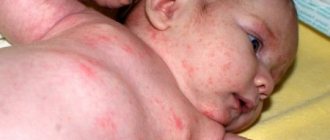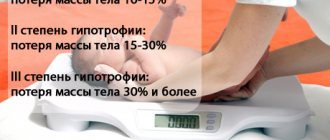Indications for use
According to the instructions, this drug is prescribed for:
- Acute and chronic diarrhea, the cause of which is an infection, an allergic reaction or the reaction of the newborn’s body to certain medications and/or antibiotics.
- Rotavirus and intestinal infections.
- Heartburn and to relieve other discomfort in the stomach, including after food poisoning.
- Treatment of diseases of the gastrointestinal tract - gastritis, gastroduodenitis, intestinal colic, peptic ulcers of the duodenum and stomach, cholecystitis.
Composition of the medicine
The composition of this medication is quite simple. The main active ingredient includes: dioctahedral smectite. This difficult name is used to refer to specially treated silicates of aluminum and magnesium. These components have a special crystalline form, which allows them to envelop all toxins, pathogenic viruses and bacteria and remove them naturally. By the way, treatment with this particular medicine is considered the most effective option for rotavirus infection, since the latter is difficult to treat with other medicines. The excipients of the drug include: glucose monohydrate, sodium saccharin and vanilla and orange flavors.
Is it possible to give Smecta to newborns?
Many parents are interested in whether Smecta can be given for jaundice or colic in newborns. Let's clarify. The fact is that not a single component of this medicine is absorbed into the blood and, accordingly, cannot accumulate in the body. That is why it is approved for use not only by adults and children over 12 years of age, but also by infants. Smecta can be prescribed for jaundice, since its cause is often considered to be the body’s inability to excrete bilirubin. As for colic, many mothers recommend using drugs with a more precise action, for example Bobotik for newborns or Bebinos.
How dosage is calculated
The dosage of the drug is calculated in each case individually, depending on the problem itself and the condition of the body. In this case, your pediatrician will be able to prescribe the most correct dosage for you. The manufacturer prescribes the required dosage depending on the age of the patient. So:
- Up to 1 year it is necessary to consume 1 sachet, that is, 3 g of the drug per day.
- From 1 year to 2 years, 1-2 sachets, that is, 3-6 g, can be prescribed.
- Over 2 years of age, 2-3 sachets per day are prescribed, that is, 6-9 g.
However, there are situations when infants are diagnosed with acute diarrhea, how then should Smecta be given for such diseases and complications? If the newborn is not yet a year old, the manufacturer recommends consuming 2 sachets for 3 days, and then 1 sachet for another 2-4 days. Children over 1 year of age are prescribed 4 sachets per day for 3 days, and then 2 sachets per day for another 2-4 days. The maximum course of treatment can be 3-7 days.
How to dilute Smecta for babies
For children whose age has not yet reached 1 year, the dosage is calculated as follows: 1 sachet of the drug (3 g) is diluted in half of 1 cup of boiled water (50 ml). It is worth giving the solution to a newborn 3-4 times throughout the day with an interval of at least 4 hours. A single dose of the suspension is equal to 20-25 g. If the baby does not want to drink it, then it is worth mixing the diluted medicine into tea, juice or semi-liquid food, for example, mashed potatoes or porridge.
A few words about the medicine
This drug is based on herbal ingredients and is considered harmless for children. The medicine belongs to the category of antidiarrheals, and with its mild effect on the gastrointestinal tract it quickly and without consequences eliminates the problem.
Smecta for babies
- The enveloping properties of the drug help protect the gastrointestinal mucosa, which helps reduce pain.
- “Smecta” is a good absorbent that copes well with toxins, viruses and bacteria. At the same time, the beneficial microflora is not disturbed, and, therefore, dysbacteriosis does not develop.
After treatment with this powder, a feeling of comfort sets in quite quickly.
Contraindications
This suspension has a small number of contraindications. These include:
- Caution should be exercised when prescribing and using the medicine for children who are prone to constipation.
- In addition, the medicine is prescribed with caution when combined with other medications. Since Smecta has a strong absorbent effect, it may reduce the effectiveness of taking another drug. If it is not possible to skip several doses of another medicine, then it must be taken at least 2-3 hours after taking this suspension.
- Contraindicated in the presence of intestinal obstruction and severe chronic constipation.
- In case of intolerance to an individual component or the entire drug.
Smecta for infants: instructions for use for newborns
Smecta for children is recommended as an antidiarrheal medication for acute or chronic diarrhea, heartburn, flatulence, and abdominal discomfort. The medicine adsorbs microorganisms and toxins on its surface. However, this remedy is not suitable for children of any age.
From the message of the National Agency for the Safety of Medicines and Medical Products (ANSM, France) it became known that Smecta® may contain lead impurities, and there is a risk of lead passing into the blood in children under 2 years of age when treated with this drug.
As a result, doctors in France are not recommended to prescribe this drug and its generics to children under 2 years of age for the treatment of acute diarrhea. These medications are also not recommended for pregnant and lactating women, for the same reason.
The Russian Union of Pediatric Centers has already sent doctors a warning from the French regulator with a recommendation to use Russian drugs instead of Smecta for children and pregnant women.
For example, the drug of first choice is Enterosgel, which meets the main safety requirement - it works only in the lumen of the gastrointestinal tract and does not penetrate through the mucous membrane into the bloodstream. Below you will find detailed instructions for using Smecta for children.
Release form
The drug is available in 2 forms:
- Suspension for oral administration. It is homogeneous yellowish-gray with a caramel smell.
- Powder for the preparation of suspension for oral administration. It can be vanilla, strawberry and orange. The color of the powder can vary from grayish-white to pale grayish-yellow. Its smell is not very pronounced, it can be non-specific or vanilla.
Indications
Smecta is a natural adsorbent. The drug, taken in therapeutic dosages, does not impair intestinal motility. It selectively adsorbs on its surface bacteria, viruses and toxic substances that are located in the lumen of the digestive tract.
The medicine stabilizes the mucous barrier of the digestive tract, it combines with mucus glycoproteins and also increases its content, improves its protective properties against microbes and their metabolic products, hydrogen ions, hydrochloric acid, and cholenic acids.
Due to these properties, Smecta is prescribed to a child if he has the following disorders:
- acute and chronic stomach upset, including those associated with allergies, treatment with certain medications, dietary errors, changes in food composition, for example, when a child enters kindergarten;
- diarrhea caused by infection, including Smecta can be caused by rotavirus and poisoning by products contaminated with pathogenic microorganisms, in this case the adsorbent should be taken in combination with other medications;
- heartburn, flatulence, discomfort in the stomach, which are associated with diseases of the digestive tract.
At what age can you start smecta?
Smecta can be taken by children from birth. The medicine has no age restrictions.
Instructions for use
The treatment regimen depends on the diagnosis and age of the patient.
In suspension, Smecta should be given to a child with acute diarrhea in the following dosages:
Age Dose
| First year babies | For the first 3 days, give the medication 2 sachets per day, then reduce the daily dosage to 1 sachet. |
| Children over 12 months | For the first 3 days, the medicine should be given in 4 sachets, then the daily dosage is reduced to 2 sachets. |
For other indications, the suspension should be given in the following doses:
Age Dose
| Babies under one year old | For patients under one year of age, give the drug 1 sachet per day. |
| From 1 to 2 years | The daily dosage for children 1-2 years old can vary from 1 to 2 sachets. |
| Over 2 years old | Children over 2 years old can be given 2 or 3 sachets per day. |
Smecta powder should be given to a child in the following doses:
Age Dosage
| Children under 12 months | Give the medicine 1 sachet per day. |
| 1-2 years | Depending on the severity of the condition, you can give 1-2 sachets per day. |
| From 2 years | The daily dosage can be 2-3 sachets. |
Before giving the suspension to a child, the closed bag with it must be kneaded to a liquid state. You can drink it undiluted or pre-dilute it in 50 ml of water. Also, small children can mix the suspension with other liquids and semi-liquid foods, including broth, compote, baby food, and purees.
In order to obtain a suspension from the powder, you need to dilute it in 50 ml of water or mix it with semi-liquid food.
During therapy, the following recommendations should be taken into account:
- The course of treatment can vary from 3 days to a week.
- If a child has esophagitis, then give Smecta to him after meals. In other cases, the medication must be taken between meals.
- During treatment, the therapeutic dosage should not be exceeded, as in this case the antidiarrheal agent may cause stool retention.
- Smecta may interfere with the absorption of other drugs. Therefore, if the child is prescribed other medications, they cannot be taken simultaneously with the adsorbent; the time interval between them should be 1-2 hours.
- To prevent the suspension from losing its therapeutic effect, it must be stored at a temperature of up to 30 degrees, and the powder - up to 25 degrees. The shelf life of the drug is 36 months, after which it must be disposed of.
- When prescribing Smecta for diarrhea, children must undergo rehydration therapy. This will prevent dehydration. The doctor may prescribe an oral rehydration solution; in severe cases, intravenous infusions of saline solutions are prescribed.
- If you have an upset stomach, you need to change your child's diet. He should not be given raw vegetables and fruits. Spices, frozen foods and drinks should be excluded from his diet. It is better to feed your baby rice.
Contraindications
Regardless of the form of release, Smecta is contraindicated in children with allergies to the composition of the drug, as well as in patients diagnosed with intestinal obstruction.
In addition, the powder is contraindicated for children who have the following pathologies:
- fruit sugar intolerance;
- impaired absorption of glucose and galactose;
- sucrase-isomaltase deficiency.
Antidiarrheals should be given with caution to children with a history of severe constipation.
Side effects
Smecta in children, regardless of the form of release, can cause the following undesirable reactions:
- allergies, which can manifest as urticaria, rashes, itching, angioedema;
- constipation;
- bloating;
- vomit.
If a child develops constipation during therapy, then it is necessary to either reduce the dosage or discontinue the medication.
The drug is radiolucent, and stool after Smecta is not stained.
Price
The price of Smecta depends on the number of sachets in the package. The cost of 10 sachets of the drug is about 140 rubles, 30 sachets is approximately 380 rubles.
Analogs
Analogues of Smecta are available for sale:
- Neosmectin;
- Polysorb;
- Enterofuril;
- Enterosgel;
- Enterol;
- Regidron;
- Linux;
- Phosphalugel.
What is better for a child: Neosmectin or Smecta?
Neosmectin is a complete analogue of Smecta for children, which costs a little less. It is available in powder for preparing a suspension, which can be vanilla, raspberry, lemon or orange.
In addition, Neosmectin differs in the composition of its auxiliary components and shelf life, which is 4 years.
There are no other significant differences between these remedies, so after consulting a doctor, you can drink any of them.
Is Polysorb or Smecta better for children?
Polysorb MP belongs to the group of adsorbents. It is available in powder for the preparation of a suspension for oral administration. As a therapeutic component, Polysorb MP contains colloidal silicon dioxide, which has a sorption and detoxification effect. The drug is used for intoxication of various origins, including those accompanied by diarrhea.
You can drink it if you have allergies, high levels of bilirubin and nitrogen-containing substances in the blood. The adsorbent should not be used if you are allergic to its composition, intestinal atony, recurrent gastrointestinal ulcers, or bleeding from the digestive tract.
That is, Polysorb MP has not only a different composition, but also indications and limitations, so the doctor must decide which remedy is better depending on the diagnosis and contraindications.
What is better Enterofuril or Smecta for a child?
Enterofuril is available in capsules and suspensions. This is an intestinal antiseptic that is used for acute diarrhea caused by bacteria, including E. coli, salmonella, clostridia, Vibrio cholerae, and staphylococci.
The drug can be used in suspension for babies older than 1 month, and capsules for patients older than 3 years. Enterofuril has other properties, it differs in indications and contraindications for use, so it is not very correct to compare it with Smecta.
For bacterial diarrhea, both medications can be taken together, but the most important thing is that the time interval between taking them is at least 1 hour.
Is Smecta or Enterosgel better for children?
Enterosgel belongs to the group of adsorbents. The medicine is commercially available in the form of a gel, regular and sweet paste.
Enterosgel can be given from birth (with the exception of sweet paste, which is allowed from the age of one year) in case of intoxication of various etiologies, allergies, high content of nitrogen-containing substances and bilirubin in the body.
It should not be taken in case of hypersensitivity to its active and additional components and intestinal atony; sweet paste is prohibited in case of intolerance to sulfonamides.
Smecta and Enterosgel are not completely interchangeable, so the doctor must decide which medication is better on an individual basis.
What is better Enterol or Smecta for children?
Enterol is an antidiarrheal drug. The medication is available in capsules and powder for the preparation of a suspension, which are used for the prevention and treatment of indigestion of various origins in patients over one year of age.
Enterol does not have an absorption effect, it has a different composition and mechanism of action, so it is impossible to say for sure which remedy is better.
Is Smecta or Regidron better for children?
Rehydron is sold in powder, from which a solution for oral administration is prepared. This is an oral rehydration product. The drug is used for diarrhea only if it is not caused by cholera. But Regidron does not normalize stool; it is recommended for restoring water-salt balance in case of indigestion.
It must be taken in combination with an adsorbent.
What is better for a child: Smecta or Linex?
Linex is classified as eubiotic. The drug is recommended for the treatment and prevention of dysbacteriosis, which is accompanied by indigestion, stool retention, bloating, abdominal pain, nausea, and vomiting.
Source: https://carmenta-med.ru/zabolevaniya/smekta-dlya-grudnichka-instruktsiya-po-primeneniyu-dlya-novorozhdennyh.html
Are there analogues
Today, several analogues of this suspension are offered on the pharmaceutical market:
- Polyphepan . This drug is considered the cheapest analogue. The medicine is produced in Russia and is available in powder form for the preparation of a suspension. It is sold in cardboard packs of 10 sachets. The main active ingredient is hydrolytic lignin.
- Diosmectite is the main “competitor”. Produced by a Russian pharmaceutical company. The main active ingredient is dioctahedral smectite. Available in powder form for preparing a suspension, a single dose is 1 sachet, that is, 3 g.
- Neosmectin . Another “Russian competitor”. In terms of release form and active substance, they are the same. However, Neosmectin is prescribed and used with caution for diabetes mellitus.
How to give and dilute Smecta to a child
The dosage of the drug is the same for the liquid and powder forms of Smecta, since the amount of the main active ingredient in them is the same and depends only on the purpose for which the medicine is used.
Important! Before opening the sachet with the liquid form of the drug, it must be thoroughly kneaded with your fingers so that the contents become homogeneous.
The drug is usually taken between meals. For bottle-fed babies, it is recommended to dissolve the contents of the sachet in 50 ml of boiled water or pre-diluted infant formula and give it in a bottle. For children already receiving complementary foods, you can mix Smecta with broth, puree or other liquid or semi-liquid food.
Important! It is not recommended to store the prepared suspension of the drug for a long time. The maximum shelf life in the refrigerator at a temperature of 6-8°C, unopened, is 16 hours.
Since the drug has an adsorbing effect, it is able to bind not only harmful, but also beneficial substances, therefore Smecta is not recommended to be taken simultaneously with other medications, including antibiotics. If such a need still exists, the drug can be given only 1-2 hours after taking it. For the same reason, Smecta should not be given during or immediately after meals. Nutrients from food can be bound by diosmectite and the child simply will not receive them.
The maximum duration of taking the drug should not be 7 days. If after this period the symptoms do not decrease or are accompanied by vomiting or fever, you should seek help from a doctor.
Reviews of Smecta for newborns
“Immediately after birth, we had jaundice and we were prescribed Smecta, as it soothes the tummy, removes bloating and removes toxins, but at the same time it strongly strengthens. When our condition more or less returned to normal, we began to drink Bebicalm for newborns alternately with Bebinos. As a result, we weren’t particularly bothered by colic.”
“Smecta is great for helping babies with diarrhea, but as for helping with colic, I doubt it. I can definitely say that dill water helped us with colic, but you can just brew dill seeds and give the baby something to drink. At the same time, almost all the mothers I know praise Espumisan for newborns. Here, it’s probably better to try to see what suits whom.”
“When the baby started having diarrhea with water, the doctor prescribed 50 ml of Smecta. After one dose, the child could not go to the toilet for almost 2 days. I got scared and immediately stopped taking the medicine. The stool has returned to normal, but if something happens, I’m afraid to give the drug again.”
“Our pediatrician prescribed us Smecta to remove bilirubin. We started having terrible constipation; we tried to save ourselves with glycerin suppositories for newborns. After stopping the medicine, literally within a day everything went away.”
“When we were in the hospital, the doctor prescribed Smecta for us, we took it for 2 days. My daughter began to have a terrible stomach ache, she screamed so much that she could only be calmed down by an injection of No-shpa. On top of that, she developed terrible constipation. In general, they canceled it, and everything became fine.”
Is it possible for newborns
Mothers are afraid to give their babies unfamiliar drugs. Those who have not yet encountered this medicine ask a completely reasonable question: is Smecta suitable for newborns. It is for infants that this product is the most gentle of all that are commercially available.
Use of “Smecta” for infants
A baby toddler will suffer from imperfections in its digestive system for up to six months, since it is only going through the formation stage. The slightest irritant becomes a serious toxin for the intestinal mucosa, causing irritation that manifests itself as diarrhea and vomiting.
Having a bag of healing powder on hand, the mother can quickly eliminate unpleasant symptoms, calming the baby. The drug is also good for infants because it is not absorbed into the blood. This means it does not give any side effects.
Video
I suggest you watch a short video that describes detailed instructions and recommendations for using a drug such as Smecta.
Any pain symptoms that appear in our newborn babies cause a huge amount of worry on the part of parents. This is not surprising for those who like to watch their baby suffer. And what can we say if the baby begins to suffer from diarrhea or vomiting. Fortunately, the modern pharmaceutical market can offer a wide selection of different products that can relieve painful symptoms in the baby’s stomach and make the life of young parents easier.
Well, now it’s your turn to tell us, have you tried Smecta to treat any diseases in your baby, what was the result? Can you recommend this drug for use by other mothers?
How to give smecta to a newborn baby: for diarrhea, colic and constipation
Our grandmothers fought colic and intestinal spasms with the help of dill water (dill seeds were specially infused), massaging the tummy, and applying a warm diaper to the painful area.
But it should be noted that dill water helps the child get rid of bloating and excess gas, but does not fight stomach disorders (constipation, diarrhea, vomiting) and pathogenic microflora that can enter the child’s body.
It is in such cases that it is necessary to treat with medications.
Since a newborn can be given a very narrow list of medications, many doctors prescribe Smecta for newborns. And here young mothers have many questions: in what doses and how often can the child be given the drug, and whether it will cause harm to the little body.
In what cases is smecta given to newborns?
The action of Smecta is very similar to the action of activated carbon or any other adsorbent substance. The main component of the drug is natural blue clay.
It acts as a kind of adsorbent, helps the body fight excess gas formation and absorbs all harmful substances and microbes.
Having 100% natural origin, the drug is completely safe for the child’s body, it passes through the gastrointestinal tract (GIT), absorbing, like a sponge, all toxins and pathogenic microbes, and is excreted unchanged. It does not have the ability to enter the blood and accumulate there.
That is why the drug is suitable for newborns. Another advantage of this drug is its pleasant taste, which is very important when taken by children.
Indications for use of Smecta:
- frequent burping of a child after he eats - what does this mean;
- stomach upsets;
- with intestinal colic, increased gas formation;
- at the first symptoms of food poisoning;
- with symptoms of intestinal dysfunction (dysbacteriosis);
- when introducing new products into the child’s diet;
- for allergic reactions.
Useful : what can be the risk of vomiting in a baby if it is not stopped in time? And the reasons for its appearance.
At what age can the drug be given?
Before giving Smecta to a child, be sure to consult a pediatrician and read the instructions for use of the drug. Smecta is an absolutely natural drug that can be given to children from the first days of life.
It is precisely due to its ability to remove toxins, but at the same time preserve beneficial intestinal microflora, that this drug is widely used. The only exceptions may be children with fructose intolerance.
Taking the drug helps to muffle pain in the child’s body and eliminate all symptoms of intoxication.
How to give Smecta to a newborn?
If the child takes medications other than Smecta, it is recommended to take them 2 hours before or after using Smecta. When taking Smecta, the effect of other dosage forms slows down. If a child experiences constipation after taking the drug, this indicates that the permissible dose has been exceeded.
It is recommended to give the drug from a spoon or bottle. If the baby refuses to take the medicine on his own, it is recommended to use a syringe without a needle. Use it to pour the required amount of medicine into the baby’s mouth.
How to divorce
In order to dilute Smecta to the required consistency, you need to pour warm liquid (boiled water, breast milk or formula) into a glass and slowly pour the contents of the sachet into it, being sure to stir constantly. The prepared suspension must be homogeneous. The prescribed dose should be given in equal parts several times a day.
When taking Smecta, you must give your child plenty of fluids throughout the day.
Dosage
The instructions for use indicate that for newborns the daily dose of the drug is one sachet, the contents of which are dissolved in 50-100 ml of breast milk or ready-made formula. If the child has severe diarrhea or vomiting, the dosage can be increased to two sachets on the first day.
The prepared solution is used orally in equal parts throughout the day. One dose should be 20-25 ml.
The course of treatment averages from 3 to 7 days. Taking the drug for longer than 7 days is contraindicated.
There are no side effects when taking Smecta. In rare cases, skin rashes may develop or the child's body temperature may increase. In this case, you must urgently contact your local pediatrician and stop taking the medication.
It will be useful: why does diarrhea begin in a baby and how to correctly distinguish it from simple loose stool?
What can be replaced
Sometimes taking Smecta is contraindicated for a child. In this case, it is necessary to use any analogue, for example: Neosmectin, Smectite, Diosmectite.
Analogs of Smecta also include Enterosgel and activated carbon. However, not all of these drugs are suitable for use in infants.
Self-medication is absolutely unacceptable; it is imperative to consult with your treating pediatrician.











